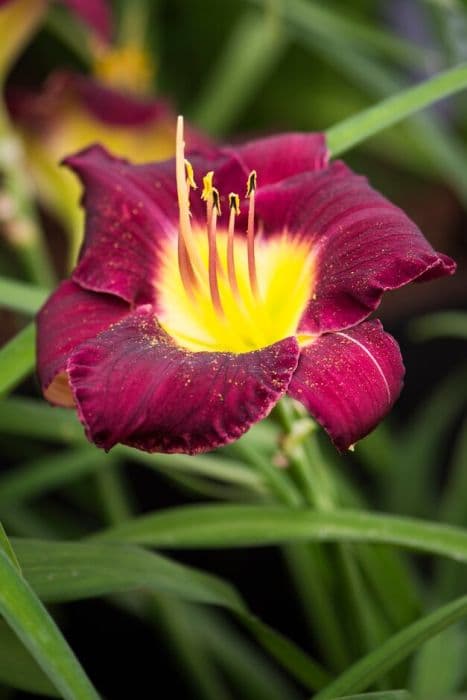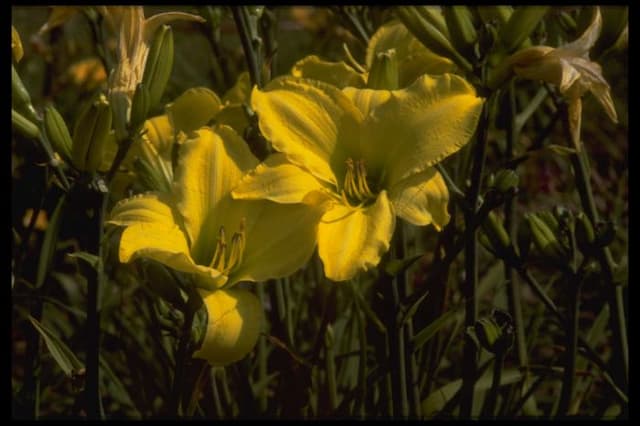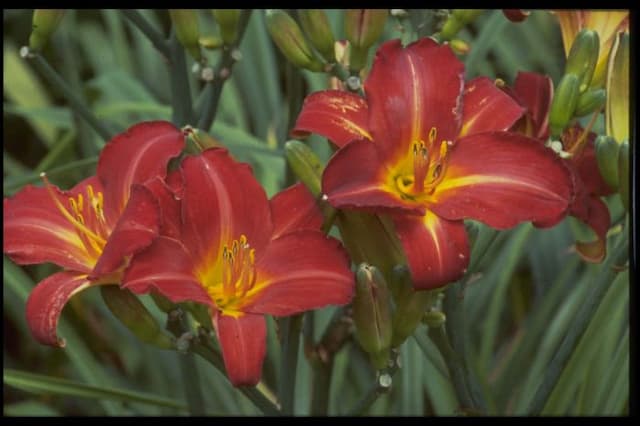Daylily Hemerocallis 'Strutter's Ball'

ABOUT
Hemerocallis 'Strutter's Ball', known widely as the Daylily, features a stunning display of blooms that are both elegant and captivating. Its flowers stand out with a deep, almost velvety, purple hue and may appear nearly black in certain lighting. Each petal is gracefully recurved and often exhibits a slightly ruffled edge, adding to the flower's sense of depth and drama. At the center of the bloom, the throat transitions into a lighter, contrasting shade, which can range from a pale yellow to a greenish-yellow tone, creating an eye-catching halo effect that highlights the flower's core. The Daylily flowers possess a silky sheen and often have a subtle ribbing texture along their length, which accentuates their form. These mesmerizing blooms sit atop sturdy, upright scapes that emerge from a clump of arching, blade-like foliage. The leaves are a vibrant green, providing a lush backdrop that makes the striking flowers stand out even more. With its sumptuous color and luxurious appearance, 'Strutter's Ball' adds a touch of sophistication to any garden space. The plant is known for its hardiness and ability to produce multiple flowers, which open for one day each, hence the common name Daylily. The display of these blooms usually takes place over a period that spans several weeks, yielding a prolonged performance of floral splendor in the garden.
About this plant
 Names
NamesFamily
Hemerocallidaceae
Synonyms
Daylily
Common names
Hemerocallis 'Strutter's Ball'.
 Characteristics
CharacteristicsLife cycle
Perennials
Foliage type
Deciduous
Color of leaves
Green
Flower color
Purple
Height
2 feet 24 inches (60 cm)
Spread
18 inches (45 cm)
Plant type
Herb
Hardiness zones
3
Native area
Asia
Benefits
 General Benefits
General Benefits- Easy to grow: Hemerocallis 'Strutter's Ball', commonly known as Daylily, is adaptable and tolerates a variety of soil conditions.
- Drought tolerant: Once established, Daylilies are quite resilient and can withstand periods of low rainfall.
- Long blooming: They produce flowers for an extended period, often from early summer to early fall, ensuring lasting garden appeal.
- Low maintenance: Daylilies require minimal upkeep relative to many other garden perennials, with little need for deadheading or pruning.
- Pest and disease resistant: They are generally resistant to pests and diseases, which reduces the need for chemical treatments.
- Versatile landscaping plant: Daylilies are suitable for a range of landscape uses, including borders, ground covers, and slope stabilization.
- Attracts pollinators: The vibrant blooms attract butterflies and other beneficial insects, promoting biodiversity in the garden.
- Aesthetic appeal: 'Strutter's Ball' has striking deep purple flowers which can be a focal point in any garden design.
- Easy propagation: They can be easily propagated by dividing the clumps every few years, allowing gardeners to expand their planting or share with others.
 Medical Properties
Medical PropertiesThis plant is not used for medical purposes.
 Air-purifying Qualities
Air-purifying QualitiesThis plant is not specifically known for air purifying qualities.
 Other Uses
Other Uses- Daylilies like 'Strutter's Ball' are often used in floral arrangements for their vivid colors and unique shape, adding a dramatic flair to bouquets.
- The sturdy, fibrous roots of daylilies can help control erosion and stabilize slopes by forming a dense network under the soil.
- Gardeners can use daylilies as natural pest deterrents, as they are not very appealing to deer and rabbits due to their slightly toxic nature.
- Dried daylily petals can be used in crafts, such as potpourri or pressed flower art, to add texture and color to a project.
- Daylilies' long leaves can be used as natural ribbons or woven into small baskets and decorative items when dried and treated properly.
- The blossoms of daylilies can serve as a colorful garnish for salads and desserts, although they should be consumed in moderation due to mild toxicity.
- Photographers and artists might utilize the striking appearance of daylilies like 'Strutter's Ball' as a subject for their work to capture their vibrant hues.
- In sustainable landscaping, daylilies are valued for their drought tolerance once established, reducing the need for frequent watering.
- During flowering season, daylilies can attract pollinators like bees and butterflies, helping to support local ecosystems.
- Daylilies can be planted to celebrate or mark events, as they bloom around the same time each year, offering a living temporal marker.
Interesting Facts
 Feng Shui
Feng ShuiThe Daylily is not used in Feng Shui practice.
 Zodiac Sign Compitability
Zodiac Sign CompitabilityThe Daylily is not used in astrology practice.
 Plant Symbolism
Plant Symbolism- Daylily: The genus Hemerocallis, commonly known as daylilies, symbolizes the ephemeral nature of life as each bloom typically lasts only for one day, reflecting the fleeting moments and the need to cherish every day.
 Water
WaterDaylilies, such as the Hemerocallis 'Strutter's Ball', prefer consistent moisture, especially during the growing season. Water the plants deeply at least once a week, providing about an inch of water each time, which equates to about 0.6 gallons per square yard of soil. In periods of drought or extreme heat, increase the frequency to twice a week, ensuring that water penetrates deeply into the soil to encourage root growth. Avoid overhead watering to minimize the risk of fungal diseases, instead focusing the water at the base of the plant. Reduce watering in the fall to prepare the plants for dormancy.
 Light
LightDaylilies thrive in full sunlight but can tolerate partial shade. To achieve the best bloom, plant Hemerocallis 'Strutter's Ball' in a location where it will receive at least six hours of direct sunlight daily. An eastern or southern exposure is ideal if you're in a cooler climate, but in hotter regions, light afternoon shade can help protect the leaves from scorching.
 Temperature
TemperatureDaylilies are hardy and adaptable, with Hemerocallis 'Strutter's Ball' growing best in a temperature range that falls between 60°F and 75°F. They can survive colder spells down to about -20°F and heat up to approximately 90°F. To thrive and produce ample blooms, maintain consistent temperatures around the ideal range during the growing season.
 Pruning
PruningPruning daylilies, including Hemerocallis 'Strutter's Ball', involves removing spent flower stems and dead foliage to encourage new growth and prevent disease. Prune after blooming, usually in late summer or early fall, cutting back the foliage to a height of about 6 inches from the ground. Removal of dead or damaged leaves can be done throughout the growing season as needed.
 Cleaning
CleaningAs needed
 Soil
SoilDaylilies ('Strutter's Ball') thrive in well-draining soil that's rich in organic matter with a pH of 6.0 to 7.0. A mix consisting of garden soil, compost, and a little sand or perlite is ideal for balancing drainage and fertility.
 Repotting
RepottingDaylilies ('Strutter's Ball') typically do not need frequent repotting if they are grown in the ground. They can be divided every 3 to 5 years to maintain vigor or when clumps become overcrowded.
 Humidity & Misting
Humidity & MistingDaylilies ('Strutter's Ball') tolerate a wide range of humidity levels and generally do not require specific humidity adjustments. They do well in the ambient outside humidity.
 Suitable locations
Suitable locationsIndoor
Ensure good light, pot in well-draining mix, divide if crowded.
Outdoor
Plant in sun/partial shade, enrich soil, water, and mulch.
Hardiness zone
3-9 USDA
 Life cycle
Life cycleThe life of Hemerocallis 'Strutter's Ball', commonly known as the Daylily, begins with seed germination, where they require a warm, moist environment to sprout. Seedlings grow into immature plants, developing a clump of grass-like foliage and establishing a strong root system. As the plant matures, it forms multiple fans from the crown, which is the point from where its leaves and flower scapes emerge. During the flowering stage, usually in early to mid-summer, the Daylily produces large, trumpet-shaped flowers that typically last only one day each, with several flowers blooming in succession over several weeks. After flowering, if pollination occurs, the plant may produce seed pods, completing its reproductive cycle. Throughout its life, the Daylily enters a period of dormancy each winter, during which the foliage dies back, and the plant conserves energy to regrow in the spring.
 Propogation
PropogationPropogation time
Early Spring
The Hemerocallis 'Strutter's Ball', commonly known as the Daylily, is often propagated in the spring or early fall. The most popular method is by division of the clumps, which are formed by the plant as it matures and spreads. To propagate by division, carefully dig up the clump of daylilies, ensuring a good amount of roots are attached to each section. Gently pull apart the fans, which are individual plant sections, making sure there are at least 3-4 fans in each new clump. These divisions can then be replanted immediately with the crown approximately 1 inch (2.54 cm) below the surface of the soil, spaced about 18-24 inches (45-60 cm) apart to allow for growth. Water thoroughly after planting to help establish root growth. This simple proceedure helps to rejuvenate older plants and multiply your daylilies effectively.









